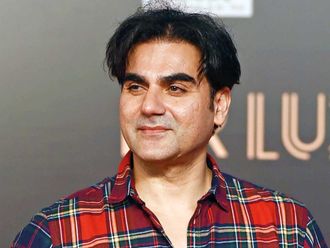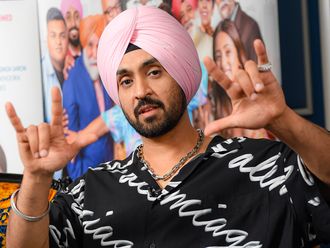Taking the High Road
By Ram Buxani, Motivate Publishing, 248 pages, Dh90
When rain clouds gathered, tribesmen in Dubai would prepare a sail with a hole in the middle — to trap rainwater and collect it. In the desert, during certain months, people would spread rags and clothes on bushes and trees overnight so that they would be soaked in dew — to be squeezed to collect water.
Not so long ago, although it sounds like a fairytale, the Bedouins used to collect potable water from Jumeirah wells in kerosene tins and transport them to Dubai on donkeys or by carts and charged 4 annas (a quarter of a rupee — then the local currency) for a tin of water.
We are talking about the 1950s, when kerosene lamps used to light up lives and power Dubai’s merchant trade economy. Dubai did not have electricity supply, except homes of the privileged few, powered by generators.
“We used to have a three-hour lunch break which was not a boon but a bane, because there wouldn’t be any power supply in our rooms during that time … but some of us soon found refuge in Santu and Champa Kripalani’s air-conditioned home,” Dr Ram Buxani, veteran non-resident Indian businessman, writes in his autobiography, “Taking the High Road”. “During the lunch break, many would go to his house to have a nap in air-conditioned comfort.”
That was Dubai until the early 1960s.
Fast-forward 50 years, and one can see a sea change, with no signs of the past except a few old low-lying buildings with wind towers in Murshid Bazaar, Deira, Bastakiya and Meena Bazaar area of the old Bur Dubai that stand as a testimony of the emirate’s not-so-distant past.
“When the Western world was walking in the twentieth century, Dubai was crawling in the nineteenth century. Then what we saw was Dubai jumping up and walking straight into the twenty-first century” — that is how Dr Buxani sees Dubai’s rise. “It can now stand shoulder to shoulder with so many so-called developed nations in terms of infrastructure and modern amenities.”
Fifty years might be a lifetime for many. But it takes centuries to build cities, nations and economies. Dubai achieved in 50 years what other economies did over centuries. Dr Buxani has correctly captured those details in his autobiography.
Life is a continuous journey. Life is also a collection of memories — where some are more interesting than others. Dr Buxani’s journey, as narrated by him in “Taking the High Road” is one of those most interesting journeys worth reading and cherishing.
This is not only a story of a young Indian and how he had built a fortune in his adopted home in Dubai, but also the story of the emergence of a global economic hub — through the eyes of an expatriate businessman.
His life history is intertwined with Dubai. If one wants to know, study and research the true history of Dubai and how the erstwhile fishing settlement has become a major trade, tourism, aviation, logistics, retail, economic and financial hub — within less than half a century — this is the textbook for them.
There is a shortage of historic references to the meteoric rise of Dubai and the making of this modern, vibrant economy. Other than the travelogue of Sir Wilfred Thesiger, and the albums of Ramesh Shukla and Noor Ali Rashid, there are few books written on Dubai’s history. In “Taking the High Road”, Dr Buxani has filled that gap to a certain extent, and with clarity.
However, what differentiates his autobiography from those written by other accomplished businessmen is the abundance of insightful thoughts that accompanies his journey. He makes deeply thoughtful and sometimes philosophical remarks about life, work and the environment while narrating various situations he encountered as he worked his way up the ladder.
“Life is one long lesson never really learned, with the pillars of trust and faith put to the test frequently and not always with the desired results …” reflects the level of his intellect. “When all passion has been spent and we’re capable of moving away from the madding crowd, we look from the outside within, a process of introspection and self-realisation that comes into our lives and threatens to overwhelm us,” he comments on his own realisation of life.
“You have to live a whole life to know certain simple things. One such thing is the very meaning of life. What is the meaning of life? After having lived a whole life, I can say with great confidence that the only meaning life can take is the one that you ascribe to it. It’s your choice,” he says in the latest edition published recently.
Time is a thief of memory. People talk of footprints in the sands of time, of images stamped in photographic detail. But the reality is quite different, he says in the opening lines of the book. “Time has a tendency to play tricks on memory. Recalling an event or experience that happened five decades ago isn’t easy …” he says, trying to be truthful to himself and to the readers and preparing them on how to treat his memoir, which could “dissipate in hazy fog”. However, his life story appears crystal clear, without any signs of the hazy fog.
Throughout the book, he remains down-to-earth and honest in describing his background: the death of his father while he was 6, the family’s migration from Pakistan’s Sindh province to India and the hardship he endured and overcame to build a fortune.
The other interesting aspects are his deep-rooted knowledge and historic references, which are nicely woven into the storytelling, making this both an enlightening and an interesting read.
Throughout the book, Dr Buxani keeps surprises after surprises, for the reader to remain hooked on to it until the end.
From the book one would learn the roots of the Sindhi community, the Indus-Valley civilisation and its comparison to the Mesopotamian civilisation, the plight of the community following the migration during the Partition in 1947, their struggles, and the revival of their fortunes later on. Besides, Dr Buxani also narrates the development of Dubai — how the late Sheikh Rashid Bin Saeed Al Maktoum built the Dubai Airport and this became a turning point in its history, with the emirate going on to become one of the major economic hubs of the world.
The book ends with images — both black and white and coloured — including rare ones of his family and his meetings with Indira Gandhi, Rajiv Gandhi, Zail Singh, Bill Clinton and Tony Blair.
Economic hardship had kept higher studies out of Dr Buxani’s reach but he later obtained a doctorate with a thesis on Dubai — its inner strength, leadership, decision-making and how it always emerged stronger from crises. He writes in the closing chapter: “Dubai has changed. This is inevitable, yet the old-timers look at Dubai only with a hint of nostalgia. The pace then was slow, yet full of life. Everyone knew everybody else. It was a city with a soul.
“One could enjoy and savour life. That, I find, is no longer possible. Dubai has become a huge, bustling city. I sometimes feel that I have become a stranger in a place where I spent the entire productive part of my life …”








